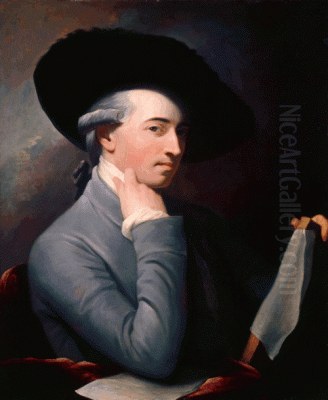
Benjamin West stands as a monumental figure in the art history of both America and Great Britain. Born in the British colony of Pennsylvania in 1738 and passing away in London in 1820, his life and career bridged the Old World and the New during a time of profound political and cultural transformation. Often hailed as the "American Raphael," West rose from humble, provincial beginnings to become a co-founder and the second president of the prestigious Royal Academy of Arts in London, and the official Historical Painter to King George III. His journey is a remarkable tale of innate talent, self-determination, European study, and transatlantic influence, leaving an indelible mark on the Neoclassical movement and the development of history painting.
An Unconventional Beginning in Pennsylvania
Benjamin West entered the world on October 10, 1738, in Springfield, Pennsylvania, within what is now the borough of Swarthmore. He was the tenth child born into a Quaker family, innkeepers by trade. This Quaker upbringing, with its emphasis on simplicity and often ambivalent stance towards the visual arts, makes his eventual career path even more extraordinary. Unlike many European artists of his stature, West lacked formal academic training in his youth. His artistic inclinations, however, manifested early and powerfully.
Anecdotes surrounding his childhood paint a picture of prodigious, almost fated, talent. One famous story recounts how, at the tender age of seven, while tasked with watching his sleeping baby niece Sally, he was captivated by her smile. Compelled to capture the fleeting expression, he supposedly fashioned a rudimentary brush from the hairs of the family cat and used ink to sketch the infant. This charming tale, whether entirely factual or embellished over time, highlights the innate drive that propelled his artistic development.
His early environment, though lacking formal art institutions, was not entirely devoid of artistic encouragement. A local gunsmith and artist named William Henry recognized the boy's potential. Henry provided West with some initial guidance and, crucially, encouraged him to move beyond simple portraiture towards more ambitious narrative subjects, planting the seeds for his later focus on history painting.
Learning from the Land and Early Mentors
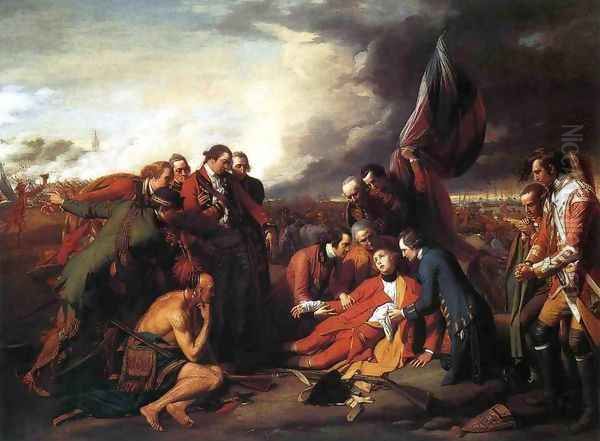
West's resourcefulness, born perhaps from necessity, became a hallmark of his early development. Legend holds that he received his first lessons in preparing colors not from European masters, but from Native Americans living near his childhood home. They reportedly showed him how to mix clays gathered from riverbanks with bear grease to create usable pigments. This connection to the local environment and its indigenous inhabitants provided him with practical knowledge unavailable through conventional means.
Further stories tell of him learning specific techniques, such as how to properly render the vibrant red breast of a bird in a painting, from a Lenape individual. These interactions underscore a unique aspect of his formative years, blending rudimentary self-instruction with knowledge gleaned from diverse, local sources. He continued to hone his skills through relentless practice and observation.
As a teenager, West began to establish himself as a portrait painter, traveling through Pennsylvania to capture the likenesses of local residents. His ambition soon led him beyond his immediate surroundings. Around 1756, he moved to the burgeoning city of Philadelphia, seeking greater opportunities and exposure. There, he encountered the work of more established painters, further refining his technique.
His time in Philadelphia brought him into contact with John Wollaston, an English painter working in the colonies. From Wollaston, West learned valuable techniques for rendering the textures of fine fabrics like silk and satin, skills that would enhance the realism and richness of his later, more complex compositions. This period marked a crucial transition from a purely intuitive artist to one actively seeking and absorbing professional methods.
A Pivotal Early Work and Growing Ambitions
While portraiture provided income, West harbored grander artistic aspirations, fueled by patrons like William Henry. A significant early commission that pointed towards his future direction was The Death of Socrates, painted around 1756. This work, depicting the classical philosopher's final moments, was ambitious for a young, largely self-taught colonial artist.
The painting caught the attention of Dr. William Smith, the provost of the College of Philadelphia (now the University of Pennsylvania). Smith was deeply impressed by West's talent and potential. He became a vital early patron, offering not only financial support but also intellectual guidance and, importantly, introductions to influential and wealthy Philadelphians. This network of support proved crucial in enabling West's next major step.
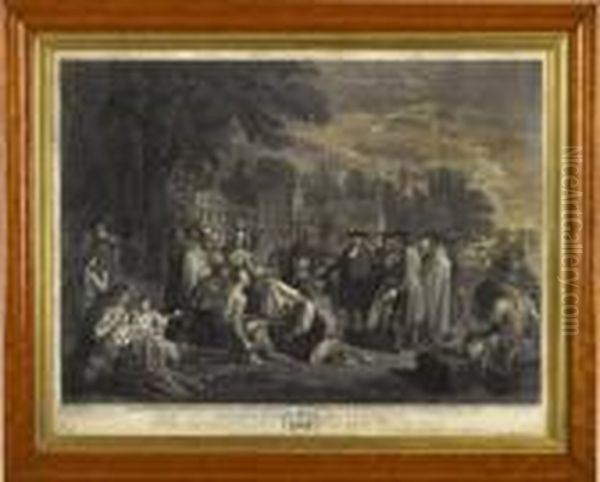
Through patrons like Smith, West's dream of traveling to Europe to study the great masters of the past began to seem attainable. The colonies, while developing culturally, lacked the vast collections of art and the established academies necessary for the highest level of artistic training, particularly in the esteemed genre of history painting. Italy, the cradle of the Renaissance and a center of the burgeoning Neoclassical movement, beckoned.
The Franklin Connection
During his time in Philadelphia, West also forged a significant relationship with one of the era's most prominent figures: Benjamin Franklin. The elder statesman recognized the young painter's promise and became a supporter and friend. This connection was more than just patronage; it represented a meeting of minds interested in the cultural development of the colonies.
Franklin's belief in West's talent was demonstrated tangibly. He was among those who helped finance West's transformative journey to Italy. This support from a figure of Franklin's stature was a considerable endorsement. West, in turn, painted portraits of Franklin, capturing the likeness of his benefactor. Furthermore, Franklin's son, William Franklin, who would later become the Royal Governor of New Jersey, was briefly a pupil of West's, highlighting the close ties between the families.
The Italian Sojourn: Embracing Neoclassicism
In 1760, Benjamin West embarked on the journey that would irrevocably shape his artistic destiny. He sailed for Italy, arriving in Rome, the epicenter of the European art world. For three years, he immersed himself in the study of classical antiquity and the masterpieces of the Italian Renaissance and Baroque periods. He diligently sketched ancient sculptures and studied the works of giants like Raphael, Michelangelo, and Titian.
His time in Italy coincided with the rise of Neoclassicism, a movement reacting against the perceived frivolity of Rococo and advocating a return to the perceived virtue, clarity, and idealized forms of Greco-Roman art. West was profoundly influenced by leading figures of this movement, particularly the German painter Anton Raphael Mengs, who was then working in Rome and considered a pioneer of Neoclassicism. He also encountered Gavin Hamilton, another key figure promoting classical ideals.
West absorbed the Neoclassical emphasis on historical accuracy (as understood at the time), moral didacticism, compositional clarity, and idealized human forms. His own style began to shift away from the lingering Baroque and Rococo influences of his colonial work towards a more restrained, linear, and classically inspired aesthetic. His talent and American origins made him something of a sensation in Rome, where he was celebrated by artists and connoisseurs.
Arrival and Acclaim in London

After his formative years in Italy, West traveled north, initially intending perhaps only a visit to London before returning to America. He arrived in the British capital in 1763. However, the reception he received was so favorable, and the opportunities so abundant, that London became his permanent home for the rest of his life.
His Italian studies and innate talent quickly gained him recognition within London's vibrant art scene. He arrived with letters of introduction and soon attracted the attention of influential figures, including Dr. Robert Hay Drummond, the Archbishop of York, who became an important early patron. Commissions began to flow, allowing West to establish a successful studio.
His American background made him a figure of interest, but it was the quality and ambition of his work, particularly his history paintings, that cemented his reputation. He skillfully navigated the social and artistic circles of London, demonstrating not only artistic prowess but also considerable diplomatic skill. His studio soon became a hub, attracting not only patrons but also aspiring artists.
Royal Patronage: Painter to the King
West's rising fame culminated in the most significant patronage relationship of his career: his connection with King George III. Introduced to the monarch, West found a receptive and enthusiastic patron who shared his interest in history and moral subjects. In 1772, the King appointed West as his official Historical Painter, a prestigious position that came with an annual stipend.
This royal appointment provided West with unparalleled opportunities and financial security. He received numerous commissions from the King, including large-scale decorative schemes for Windsor Castle, featuring grand historical and religious subjects. He painted portraits of the royal family and documented significant events. This close relationship with the Crown lasted for decades, making West one of the most prominent artists in the British Empire.
The King's patronage not only elevated West's status but also significantly influenced the direction of British art, lending royal authority to the Neoclassical style and the genre of history painting that West championed. West's works adorned royal residences and public spaces, shaping the visual culture of the era.
Founding the Royal Academy of Arts
Benjamin West played a pivotal role in the establishment of one of Britain's most enduring cultural institutions: the Royal Academy of Arts. In 1768, he was among the group of 36 founding members who petitioned George III to establish an academy dedicated to promoting the arts of design through education and exhibition.
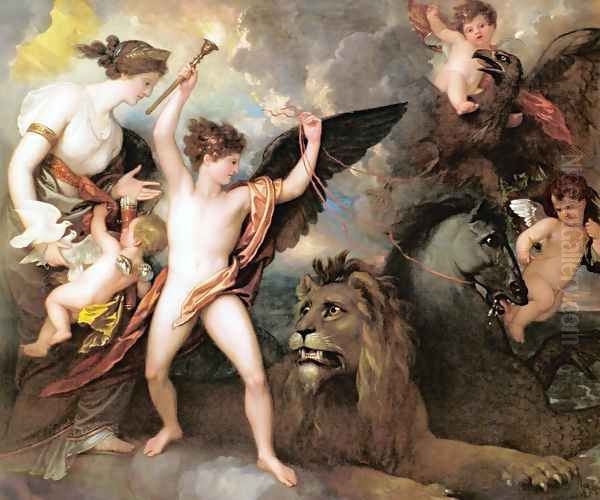
The King granted the charter, and the Royal Academy was born, with the renowned portrait painter Sir Joshua Reynolds elected as its first president. West was a central figure from the outset, actively involved in the Academy's formation and early activities. His involvement underscored his commitment to raising the status of artists and providing structured training for future generations, mirroring the academies he had observed in Italy.
The Royal Academy quickly became the focal point of the London art world, hosting annual exhibitions that were major social and cultural events. West was a regular and prominent exhibitor, showcasing his major history paintings and contributing to the Academy's prestige.
Presidency of the Royal Academy
Following the death of Sir Joshua Reynolds in 1792, Benjamin West was elected as the second president of the Royal Academy of Arts. This was a remarkable achievement for an artist born in the American colonies, signifying his complete acceptance and esteemed position within the British art establishment. He held the presidency, with one brief interruption (1805-1806 when James Wyatt held the post), until his own death in 1820.
As president, West oversaw the Academy's schools, exhibitions, and administration. He continued the tradition established by Reynolds of delivering annual discourses to the students, offering guidance on artistic theory and practice. While perhaps lacking Reynolds's literary flair, West was respected for his dedication and his support of younger artists.
His presidency was not without its moments of characteristic independence. It is said that George III offered West a knighthood, a customary honor for the RA president, but West declined, possibly feeling it insufficient or perhaps retaining a sense of his simpler Quaker or American republican roots. Despite this, he remained firmly entrenched in the highest echelons of the British art world.
Revolutionizing History Painting: The Death of General Wolfe
West's most revolutionary contribution to art history came in 1770 with his painting The Death of General Wolfe. The work depicted the final moments of the British general James Wolfe during the Battle of Quebec in 1759, a pivotal event in the Seven Years' War. While the subject matter was suitably heroic and historical, West made a radical decision regarding its execution.
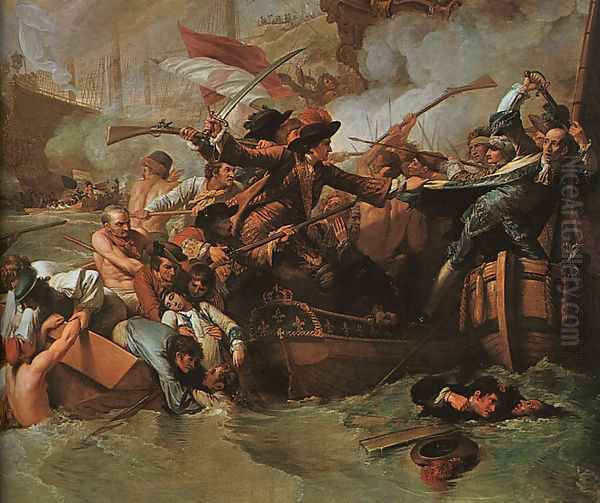
Instead of clothing the figures in classical robes, as was the convention for history painting (even when depicting relatively recent events), West chose to portray Wolfe and his officers in their contemporary military uniforms. This insistence on historical accuracy in costume was groundbreaking and initially met with resistance, even reportedly from Sir Joshua Reynolds and King George III himself, who felt it detracted from the dignity and timelessness expected of the genre.
West, however, remained steadfast, arguing for the importance of depicting the event truthfully as it occurred. He believed that the heroism of the figures was inherent in their actions and did not require the artificiality of classical attire. His gamble paid off spectacularly.
When exhibited at the Royal Academy in 1771, The Death of General Wolfe was an enormous success. The public was captivated by its dramatic composition, emotional intensity, and, crucially, its sense of immediacy and realism. Even the King eventually came to admire the painting, commissioning a copy for himself. The work was widely reproduced through engravings, spreading West's fame throughout Britain and beyond. It fundamentally changed the conventions of history painting, paving the way for greater realism in the depiction of modern historical events. Other artists, like his own student John Trumbull, would follow his example.
Chronicling History, Myth, and Religion
Following the triumph of Wolfe, West solidified his reputation as the preeminent history painter of his generation in Britain. He produced a vast body of work encompassing historical, mythological, and biblical subjects, executed in his evolving Neoclassical style.
William Penn's Treaty with the Indians (c. 1771-72) revisited his American roots, depicting the legendary peaceful agreement between Pennsylvania's founder and the Lenape people. This work, commissioned by Penn's descendants, presented an idealized vision of colonial-Indigenous relations, reflecting both historical narrative and Quaker values.
Other significant history paintings included Agrippina Landing at Brundisium with the Ashes of Germanicus, a subject drawn from Roman history that exemplified Neoclassical ideals of stoicism and civic virtue. He also tackled subjects from British history, such as scenes from the life of King Edward III for Windsor Castle. His compositions were typically carefully structured, often featuring dramatic lighting and gestures designed to convey the emotional and moral core of the narrative.
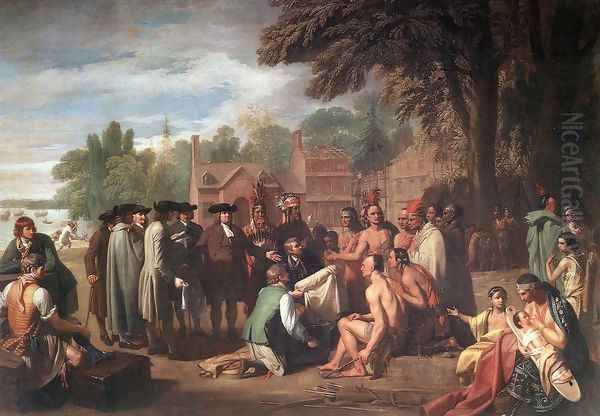
His style skillfully blended the formal order and idealized figures characteristic of Neoclassicism with a sense of drama and emotional intensity that foreshadowed Romanticism. He was a master of composition, arranging complex groups of figures in clear, readable designs. His use of light and shadow (chiaroscuro) enhanced the dramatic effect, while his application of "aerial perspective"—using subtle shifts in color and clarity—created a convincing sense of depth.
A Shift Towards Religious Themes
In the later part of his career, particularly after the turn of the century, West increasingly turned his attention to large-scale religious subjects. This shift may have reflected his own deepening spiritual interests, the preferences of patrons, or a desire to engage with the most profound themes of human existence.
He produced monumental canvases such as Christ Healing the Sick (1811), which was exhibited to great acclaim and purchased for the National Gallery (though initially displayed at the British Institution). Its success spurred him to create even larger and more dramatic religious works. Saul and the Witch of Endor explored supernatural themes from the Old Testament, while Death on a Pale Horse (versions exist from c. 1796 and 1817) presented a terrifying, apocalyptic vision drawn from the Book of Revelation, showcasing a move towards the sublime and the more overtly Romantic sensibilities.
Other notable late works include Cicero Discovering the Tomb of Archimedes (1804) and Omnia Vincit Amor (Love Conquers All, 1815). These later works often maintained Neoclassical clarity in composition but embraced heightened emotion and sometimes more dynamic, energetic brushwork, reflecting the changing artistic currents of the early 19th century. He continued to work prolifically even in old age.
The London Studio: An American Nexus
Beyond his own artistic production, Benjamin West exerted a profound influence as a teacher and mentor, particularly for aspiring artists from his native America. His London studio became a crucial destination for young Americans seeking advanced artistic training in Europe. For several decades, West generously offered guidance, instruction, critiques, and access to his own collections and connections.
He effectively served as an unofficial cultural attaché, welcoming and nurturing generations of American talent. Among the many prominent American artists who studied with or sought advice from West were John Singleton Copley (who arrived in London already established but benefited from West's circle), Gilbert Stuart (future portraitist of George Washington), John Trumbull (known for his paintings of the American Revolution), Charles Willson Peale (patriarch of the Peale artistic dynasty), Rembrandt Peale (Charles's son), Matthew Pratt, Washington Allston, Thomas Sully, and Samuel F. B. Morse (later inventor of the telegraph).

West's influence on these artists was multifaceted. He provided technical instruction grounded in the European academic tradition, exposed them to Neoclassical principles, encouraged their ambitions in history painting, and helped them navigate the London art world. His support was instrumental in shaping the course of early American art, earning him the informal title "Father of American Painting."
Contemporaries and Connections
West's long career placed him at the center of the London art world, interacting with numerous other significant artists. His relationship with Sir Joshua Reynolds was pivotal, first as a fellow founder of the RA and later as his successor to the presidency. While stylistically different—Reynolds being primarily a portraitist known for his Grand Manner—they were the two dominant figures of their era in British art.
He would also have known Thomas Gainsborough, Reynolds's great rival in portraiture. Other RA colleagues included the Swiss-born painter Angelica Kauffman and the English flower painter Mary Moser, the only two female founding members. He interacted with artists exploring different facets of Romanticism, such as the visionary Henry Fuseli, known for his depictions of the supernatural and the sublime, and the Neoclassical sculptor John Flaxman.
While deeply embedded in the British scene, West maintained connections across the Channel, aware of developments in France through artists like Jacques-Louis David, the leading figure of French Neoclassicism. However, there is no record of significant interaction with Spanish master Francisco Goya, whose artistic path, while contemporary, unfolded largely independently in Spain, exploring darker psychological and social themes.
Innovations and Inquisitive Mind
West possessed an intellectually curious mind that extended beyond painting. An intriguing anecdote suggests he independently observed the principle of the camera obscura. Supposedly, while recovering from a fever in a darkened room, he noticed an inverted image of the scene outside projected onto the ceiling or wall through a small hole in the shutters. While the camera obscura was already known, this story illustrates his keen powers of observation and interest in optical phenomena, traits valuable to any visual artist.
Later Life and Enduring Legacy
Benjamin West remained active as an artist and as President of the Royal Academy into his final years. He died at his home in Newman Street, London, on March 11, 1820, at the venerable age of 81. His death marked the end of an era in British art. He was afforded the high honor of burial in St. Paul's Cathedral, a testament to the immense respect he commanded.

While some sources mention a late-life return to America, he definitively died and was buried in London. His connection to America, however, remained profound throughout his life, maintained through correspondence, his mentorship of American artists, and his choice of American historical subjects like Penn's Treaty.
Benjamin West's legacy is substantial and multifaceted. He was a key figure in the Neoclassical movement, adapting its principles to history painting with groundbreaking results. His Death of General Wolfe irrevocably changed the genre. As Historical Painter to George III, he produced a significant body of work that defined royal taste for decades. Perhaps most enduringly, his role as a mentor to generations of American artists makes him a foundational figure in the history of American art, acting as a crucial conduit for transmitting European academic traditions and artistic ideals across the Atlantic. He remains a symbol of the complex and fruitful artistic exchange between Britain and America during a formative period for both nations.